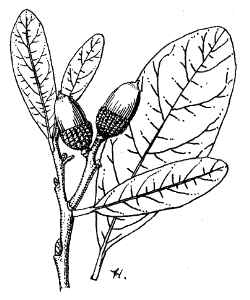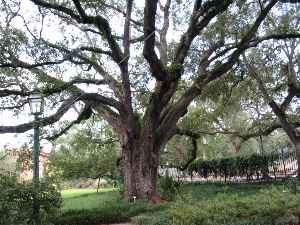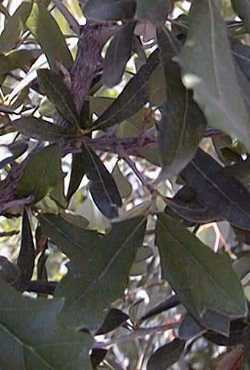Sunset®: 4-31
USDA: 8b-10
Frost Tolerance: Hardy to 15° F (-10° C)
Sun Exposure: Full sun
Origin: Southeastern USA
Growth Habits: Tree up to 60 feet tall (18 m)
Flowers: Light yellow or greenish flowers
Watering Needs: Regular water to abundant water
Propagation: Seeds (acorns)
Propagation: Seed or occasionally cutting, grafting/budding
- by semi-hardwood stem tip cuttings, in summer. Apply IBA TALC 16000 PPM. Use intermittent mist. Root in 10-12 weeks. Juvenile cuttings should be pencil size..
- by grafts, in late winter. Use a White oak group as graftstock. Scions should be pencil size.
- by seeds, in spring. The seeds can be harvested in autumn. No pre-treatment is needed.

Quercus virginiana L., live oak is most commonly found on the lower Coastal Plain of southeastern United States. The tree can grow up to an average of 50 feet in height and 36-48 inches in diameter, but can have trunks over 70 inches in diameter. The bark is furrowed longitudinally, and the small acorns are long and tapered. The bark and twigs are dark to light grayish color and becomes darker with age. The leaves are thick, shiny, and dark green on top, lighter below. Small flowers are produced when new leaves are grown. The fruit which is the acorn is about 1 inch long cup, somewhat narrowed at the base. Root crowns and roots survive fire and sprout vigorously.

Culture:
Live oak grows in moist to dry sites. It withstands occasional floods, but not constant saturation. It is resistant to salt spray and high soil salinity. Live oak grows best in well-drained sandy soils and loam but also grows in clay and alluvial soils. Live oak is intermediate in shade tolerance.
Once established, it withstands competition. They are extremely salt tolerant and this resistance may account for its dominance in many climax coastal forests in the northern part of its range. Dense stands of live oak reduce forage production for livestock. Live oak is extremely hard to kill because it sprouts vigorously from the root collar and roots.
Propagation:
The acorns must be fresh and not dried. Make sure that the squirrels don't go after them after they are planted. Seeds and seedlings can be collected in the wild when the acorns mature and fall and then begin sprouting. It can also be obtained commercially from forest seed companies. Approximate seed per pound: 352.
Source USDA/NRCS
Desert-Tropicals is dedicated to provide gardening advice, gardening ideas, and information about flower of all kind for landscape and collections.We try to check carefully the identification of the plants on the illustrations as well as the other information from the page, but occasionally errors do occur. if you notice anything that needs to be changed please contact us.Thanks.
© 1998-2020 Philippe Faucon, All Rights Reserved.
